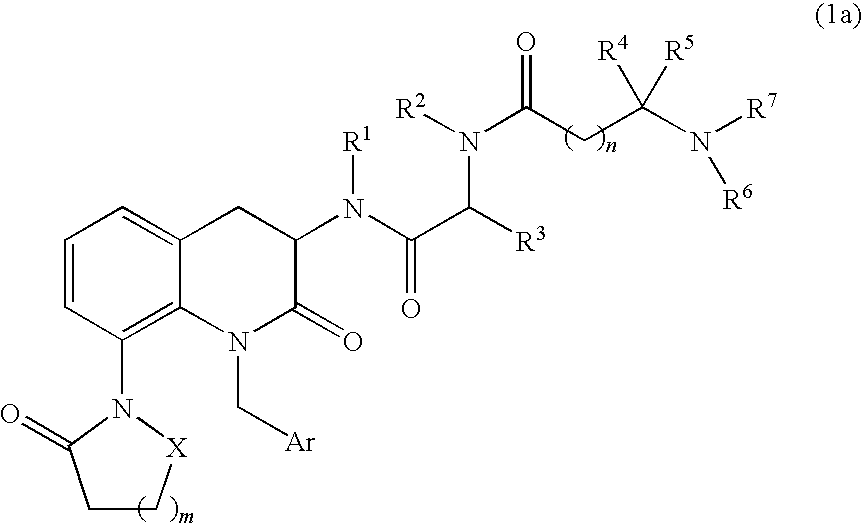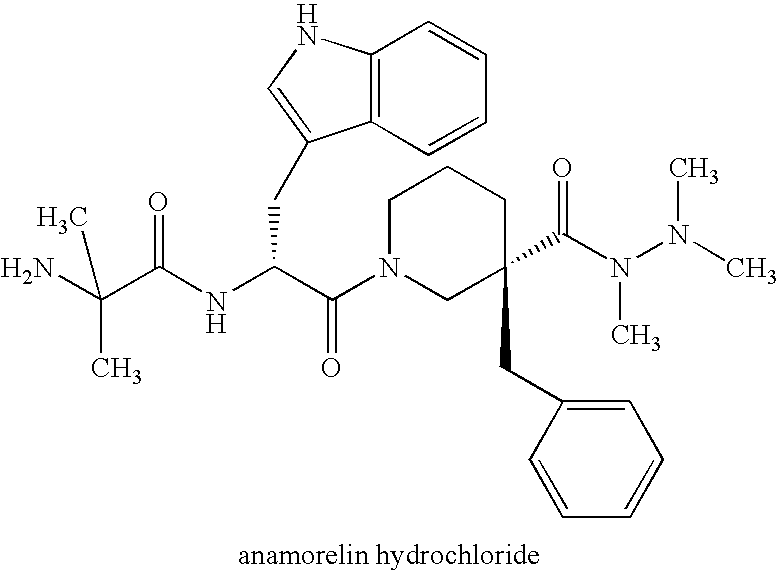3,8-diaminotetrahydroquinoline derivative
a technology of diaminotetrahydroquinoline and diaminotetrahydroquinoline, which is applied in the direction of antibacterial agents, drug compositions, and metabolic disorders, can solve the problems of muscle and bone loss, impairment of qol of the aged, etc., and achieves potent agonistic activity on ghs-r, short stature, and high safety
- Summary
- Abstract
- Description
- Claims
- Application Information
AI Technical Summary
Benefits of technology
Problems solved by technology
Method used
Image
Examples
example 1
Synthesis of N-(2-oxo-1,2,3,4-tetrahydroquinolin-3-yl)acetamide
[0133]
[0134]Under a stream of argon, N,N-dimethylacetamide (2.0 L) was added to a mixture of diethyl acetamidomalonate (553 g) and 2-nitrobenzyl bromide (500 g) while the mixture was cooled on ice. 21% NaOEt-ethanol solution (749.97 g) was added dropwise to the mixture over 30 minutes while the inside temperature was maintained at 10 to 22° C. After completion of dropwise addition, the resultant mixture was stirred for one hour while the inside temperature was maintained at 20 to 25° C. (formation of Compound c). The thus-obtained reaction mixture was divided into two equiamount portions, and each portion was subjected to the following procedure.
[0135]Specifically, 10% Pd—C (26.1 g) was added to the portion, and hydrogen displacement was performed five times. While maintained at an inside temperature of 60 to 85° C., the mixture was vigorously stirred for five hours (formation of Compound d). The reaction mixture was coo...
example 2
Synthesis of N-(6-bromo-2-oxo-1,2,3,4-tetrahydroquinolin-3-yl)acetamide
[0145]
[0146]Acetic acid (3,240 mL) was added to N-(2-oxo-1,2,3,4-tetrahydroquinolin-3-yl)acetamide (405.8 g), and the acetamide was dissolved in acetic acid at an inside temperature of 51° C. The reactor was cooled to an inside temperature of 25° C., and sodium acetate was added thereto. To the mixture maintained at an inside temperature of 25° C., bromine was dropwise added over 30 minutes under stirring. The reaction mixture was added to water (35 L), and the reactor was washed with water (3.24 L). The thus-obtained mixture was stirred at 24° C. for one hour.
[0147]Separately, the above procedure was repeated, and the obtained two batches were combined. The mixture was filtered, to thereby recover precipitates. The recovered precipitates were sequentially washed with water (405 mL×2) and ethanol (1,500 mL) and then dried in air, whereby the title compound (768.0 g) was yielded.
[0148]Ms(FAB)m / z 283 (M+H)+
[0149]1H...
example 3
Synthesis of N-(6-bromo-8-nitro-2-oxo-1,2,3,4-tetrahydroquinolin-3-yl)acetamide
[0151]
[0152]N-(6-Bromo-2-oxo-1,2,3,4-tetrahydroquinolin-3-yl)acetamide (497.0 g) was added to sulfuric acid (4 L) under stirring, while the inside temperature was maintained at 26 to 46° C. (washed with sulfuric acid (500 mL)). Then, while the inside temperature was maintained at 15° C. or lower, 600 nitric acid (193.6 g) was added thereto (washed with sulfuric acid (470 mL)).
[0153]Separately, the above procedure was repeated, and the obtained reaction mixtures were sequentially poured to 500 ethanol (15.9 L). The reactor was washed with water (7.95 L), and the mixture was stirred at 20° C. for one hour. The precipitates were recovered through filtration and washed sequentially with water (7.95 Lx2) and ethanol (954 mL). The washed product was dried at 60° C. under reduced pressure, whereby the title compound (908.0 g) was yielded.
[0154]Ms(FAB)m / z 328 (M+H)+
[0155]1H-NMR (400 MHz, DMSO-d6):
[0156]δ(ppm) 1.9...
PUM
| Property | Measurement | Unit |
|---|---|---|
| temperature | aaaaa | aaaaa |
| temperature | aaaaa | aaaaa |
| temperature | aaaaa | aaaaa |
Abstract
Description
Claims
Application Information
 Login to View More
Login to View More - R&D
- Intellectual Property
- Life Sciences
- Materials
- Tech Scout
- Unparalleled Data Quality
- Higher Quality Content
- 60% Fewer Hallucinations
Browse by: Latest US Patents, China's latest patents, Technical Efficacy Thesaurus, Application Domain, Technology Topic, Popular Technical Reports.
© 2025 PatSnap. All rights reserved.Legal|Privacy policy|Modern Slavery Act Transparency Statement|Sitemap|About US| Contact US: help@patsnap.com



